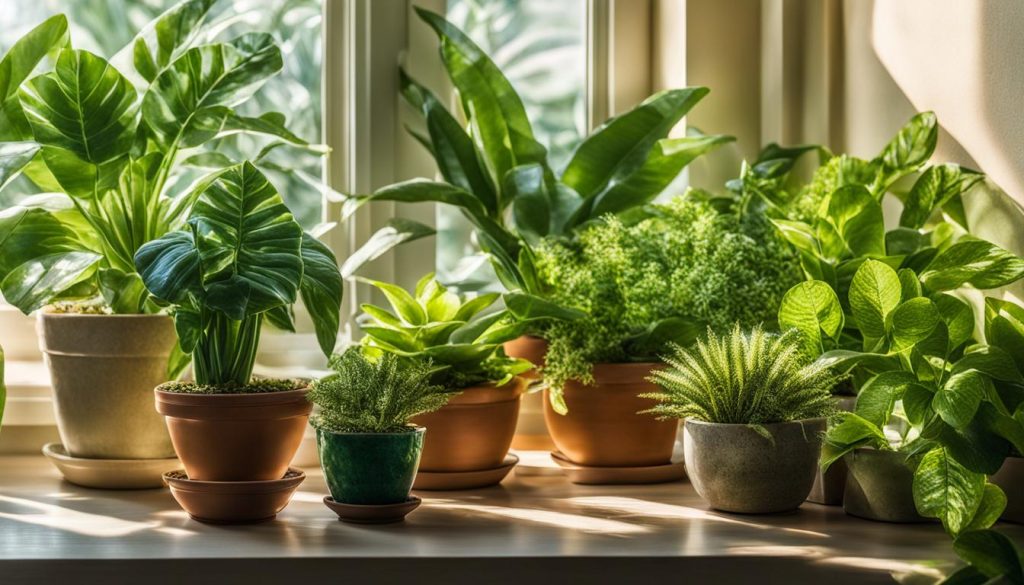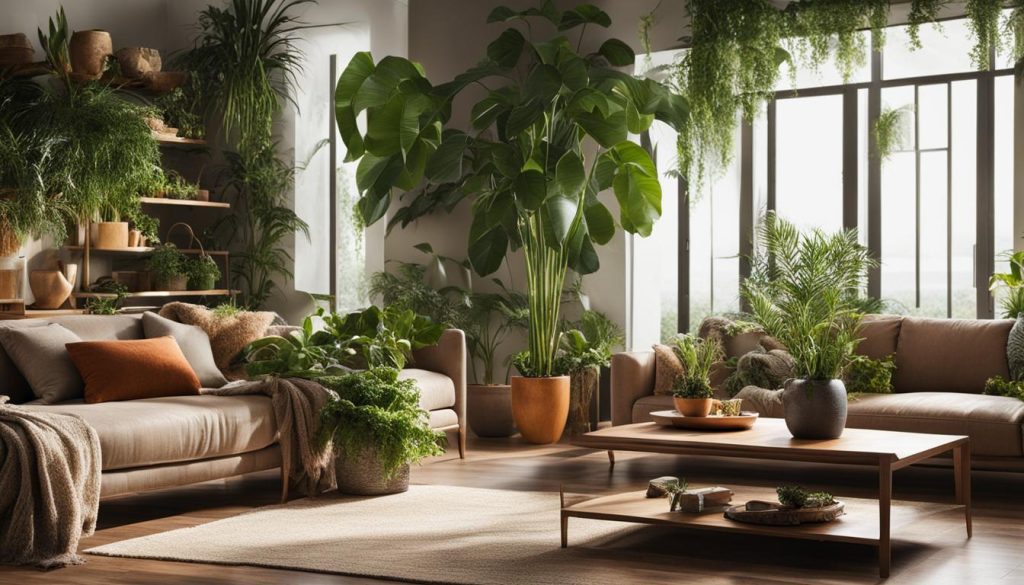Breathing clean air is important no matter where you spend your time. Indoor air can be 2-5 times more polluted than outdoor air, according to the Environmental Protection Agency. To improve indoor air quality, air purifying indoor plants can be a valuable addition to any space.
These plants not only add natural beauty but also absorb toxins, including common volatile organic compounds (VOCs) like benzene and formaldehyde. It’s recommended to have at least two interior air purifying plants per 100 square feet for maximum effectiveness.
Discover Houseplants That Clean Air
- Air purifying indoor plants can help improve indoor air quality and remove toxins.
- Indoor air can be much more polluted than outdoor air.
- Common toxins like benzene and formaldehyde can be absorbed by air purifying plants.
- Having at least two interior air purifying plants per 100 square feet is recommended for maximum effectiveness.
- These plants not only clean the air, but also add natural beauty to any space.
Best Air Purifying Plants for Indoor Spaces
When it comes to improving indoor air quality, certain plants excel at purifying the air. These air-purifying houseplants not only add natural beauty to your space but also help filter out toxins, making your indoor environment cleaner and healthier.
Here are some of the best houseplants for clean air:
- Bamboo Palm: This plant is known for its exceptional air-filtering abilities. It filters formaldehyde, benzene, xylene, and chloroform, making it a top choice for natural air cleaners.
- Spider Plant: Not only is the Spider Plant low-maintenance, but it also removes formaldehyde and xylene from the air. It’s a versatile and effective air-purifying houseplant.
- Gerbera Daisy: In addition to its beautiful flowers, the Gerbera Daisy absorbs benzene and formaldehyde. It adds a pop of color to your indoor space while working as a natural air cleaner.
- Snake Plant: With its striking upright leaves, the Snake Plant is another great choice for air purification. It filters formaldehyde, benzene, toluene, and trichloroethylene. However, it’s important to note that the Snake Plant is toxic to pets, so it’s best to keep it out of reach.
- Chrysanthemum: Known for its vibrant blooms, the Chrysanthemum eliminates ammonia and benzene from the air. While it has air-cleaning properties, it may cause allergies in some individuals, so be mindful if you have sensitivity to pollen.
- Peace Lily: The Peace Lily is not only a beautiful plant but also a natural air purifier. It removes volatile organic compounds (VOCs) from cosmetics and household cleaners. It thrives in low-light conditions, making it a perfect choice for areas with less natural sunlight.
- Aloe Vera: Aside from its renowned healing properties for skin irritations, Aloe Vera is also effective at purifying the air. It filters formaldehyde and benzene, making it a wonderful addition to your indoor space.
These best air purifying plants offer a range of options to suit different preferences and indoor environments. Whether you prefer a plant that adds a touch of color or one that thrives in low-light conditions, you can find the perfect air-purifying houseplant to enhance your indoor air quality.
To visualize the beauty of these air purifying plants, take a look at this stunning image:
Now that you know the best houseplants for clean air, it’s time to bring nature indoors and enjoy the benefits of natural air cleaners.
How Do Plants Purify Air?
Plants play a vital role in purifying the air around us. Through the process of photosynthesis, they absorb carbon dioxide and release oxygen, making them a valuable addition to any home or indoor space. But their air purification benefits go beyond oxygen production.
Certain plants have the ability to filter out airborne toxins, such as benzene, formaldehyde, and ammonia, improving the indoor air quality and creating a healthier living environment. These plants act as natural air purifiers, effectively removing harmful pollutants from the air we breathe.
Studies have shown that plants can effectively filter toxins and chemicals commonly found in indoor environments, including those emitted by household cleaners, furniture, and building materials.
How Plants Filter Toxins
Plants have microscopic openings on their leaves, called stomata, which allow them to take in gases from the air. As air circulates around the plant, these tiny openings capture airborne toxins and pollutants, trapping them on the leaf surface.
This process is further enhanced by the microorganisms present in the plant’s root zone, which assist in breaking down and neutralizing harmful compounds. As a result, the air surrounding the plant becomes cleaner and healthier.
Houseplants for Better Air Quality
When choosing houseplants for better air quality, it’s important to consider their ability to filter specific toxins. Some common air-purifying plants include:
- Snake Plant: Known for its ability to filter formaldehyde, benzene, toluene, and trichloroethylene.
- Pothos: Effective at removing formaldehyde and carbon monoxide from the air.
- Spider Plant: Filters formaldehyde, xylene, and other harmful chemicals.
- Peace Lily: Removes common indoor pollutants and adds a touch of beauty to any space.
- Bamboo Palm: Known for its ability to filter formaldehyde, benzene, and other toxins.
Placing these plants strategically throughout your home can help improve the air quality and create a healthier living environment. It’s recommended to have at least two to three air-purifying plants per 100 square feet of space for maximum effectiveness.
In the next section, we’ll explore the numerous benefits of incorporating air-purifying plants into your indoor space.
The Benefits of Air Purifying Plants
Adding air purifying plants to your home or office offers numerous benefits. Not only do they help remove toxins from the air, but they can also improve overall mood and well-being. Plants have been shown to reduce stress levels, increase productivity, and create a sense of calm.
Additionally, air-cleaning houseplants can help moisturize the air, reducing dryness and improving respiratory health. With their natural beauty and ability to filter indoor air, these plants are a wonderful addition to any indoor space.

Whether it’s through their natural air-purifying properties or the visual appeal they bring to a room, houseplants for improved indoor air quality have a positive impact on our lives. They not only add a touch of nature to our surroundings but also contribute to a healthier and more enjoyable living environment.
Houseplants That Help Clean Air in Florida
In Florida, where indoor air quality can be affected by humidity and high temperatures, it is important to choose houseplants that excel at purifying the air. These plants not only add beauty to your space but also filter out toxins, creating a healthier living environment.
1. Philodendrons
Philodendrons are highly effective at removing formaldehyde and other pollutants from the air. They come in a variety of shapes and sizes, making them a versatile choice for any indoor space.
2. Aglaonema
Aglaonema is a low-light plant that thrives in areas with minimal sunlight. It is known for its ability to remove pollutants from the air, making it an ideal choice for spaces with limited natural light.
3. Aloe Vera
Aloe Vera is a hardy succulent that not only removes toxins from the air but also has healing properties for skin ailments. It requires minimal care and is a great addition to any indoor garden.
4. Dracaena
Dracaena is a group of plants that comes in various species, all of which help eliminate air pollutants. They prefer moderate sunlight and are a perfect choice for brightening up your space while improving air quality.
5. Spider Plant
Spider plants are easy to grow and are excellent at removing formaldehyde and carbon monoxide from the air. They are a popular choice for beginners and can thrive in a variety of indoor conditions.
By incorporating these houseplants into your indoor space, you can create a healthier and fresher environment. They not only improve air quality but also add a touch of nature to your surroundings.
Houseplants That Clean Indoor Air: A Closer Look
Taking a closer look at specific houseplants that clean indoor air, we find that:
- Spider Plants: These plants are highly effective at removing formaldehyde, carbon monoxide, and other toxins from the air. They are easy to care for and can thrive in various lighting conditions.
- Philodendrons: Known for their ability to filter formaldehyde and other volatile organic compounds, philodendrons are a popular choice for indoor air purification. They come in a variety of species and sizes, making it easy to find the perfect fit for your space.
- English Ivy: This low-maintenance plant not only adds a touch of greenery to your home but also helps eliminate various indoor pollutants. It is particularly effective at reducing airborne mold particles, making it a great choice for those who suffer from allergies.
- Peace Lilies: With their elegant white blooms, peace lilies not only beautify your space but also remove allergens and volatile organic compounds (VOCs) from the air. They prefer moderate to low light conditions, making them ideal for indoor environments.
- Snake Plants: Also known as mother-in-law’s tongue, snake plants are excellent air purifiers. They are particularly effective at filtering formaldehyde, benzene, toluene, and trichloroethylene. Snake plants are low-maintenance and can tolerate a variety of light conditions, making them perfect for beginners.
- Bromeliads: These tropical plants release oxygen and filter air pollutants, making them ideal for bedrooms. They come in a range of vibrant colors and require minimal care, adding a pop of beauty to your space.
- Dracaena plants: The Warneck and Janet Craig varieties of Dracaena are highly effective at removing air pollutants. These plants thrive in moderate sunlight and can tolerate lower light conditions, making them versatile options for various indoor spaces.
Choose the Right Plants for Cleaner Air
When selecting indoor plants for cleaner air, it’s important to consider factors such as lighting conditions, maintenance requirements, and the specific pollutants you want to target. By incorporating these air-purifying houseplants into your indoor spaces, you can enjoy cleaner and fresher air.
The Effectiveness of Indoor Plants in Air Purification
While the effectiveness of indoor plants in air purification has been a topic of debate, studies have shown that they do have a positive impact on indoor air quality. Indoor air pollution is a serious concern, with harmful chemicals often trapped in our homes and offices. Air-cleaning indoor plants offer a natural solution to this problem.
Indoor plants, such as the best houseplants for improved air quality, have the ability to absorb pollutants from the air. They act as natural filters, capturing toxins and breaking them down into harmless compounds. This process contributes to cleaner air over time, promoting a healthier living environment for you and your loved ones.
However, it’s important to note that indoor plants alone may not be sufficient to completely purify the air. While they are effective at removing certain toxins, they may not eliminate all pollutants at a rapid rate. It is recommended to combine the use of indoor plants with other air-cleaning methods, such as proper ventilation and the use of air purifiers, for optimal results.
Adding air-cleaning indoor plants to your living spaces has other benefits as well. Beyond improving air quality, houseplants have been known to enhance well-being and create a sense of tranquility. They add natural beauty to your home or office and can reduce stress levels, boost productivity, and promote relaxation.
When choosing the best houseplants for improved air quality, consider plants like Spider Plants, Peace Lilies, and English Ivy, as they have proven air-purifying abilities. These plants not only add aesthetic value but also contribute to a healthier and more pleasant indoor environment.

Conclusion
Incorporating indoor plants for air purification is a smart choice for enhancing the quality of air in your indoor spaces. These natural air purifiers offer numerous benefits, including filtering out toxins and creating a healthier living environment. While the effectiveness of different houseplants may vary, adding a variety of indoor plants to your home or office can have a positive impact on both your physical and mental well-being.
By harnessing the power of these natural air purifiers, you can improve the air quality in your space and enjoy the benefits they bring. Not only do these houseplants filter out harmful toxins, but they also add beauty and a sense of tranquility to your surroundings. From absorbing common volatile organic compounds (VOCs) like benzene and formaldehyde to releasing oxygen, indoor plants work tirelessly to promote a cleaner and healthier indoor atmosphere.
So why wait? Take a step towards fresher and cleaner air by incorporating indoor plants for air purification. Whether it’s the bamboo palm, spider plant, or peace lily, there is a wide range of options to choose from. Embrace the natural air-cleaning abilities of houseplants and breathe in the benefits of improved air quality. Your well-being and the health of your indoor spaces will thank you.
FAQ
What are the benefits of air purifying plants?
Air purifying plants not only filter out toxins and improve indoor air quality but also have numerous other benefits including reducing stress levels, increasing productivity, and creating a sense of calm. They also help moisturize the air, reducing dryness and improving respiratory health.
How do plants purify air?
Plants use a process called photosynthesis to purify the air. They absorb carbon dioxide and release oxygen, effectively improving the air quality. Certain plants also have the ability to absorb airborne toxins such as formaldehyde, benzene, and ammonia.
Which plants are effective at air purification?
Some of the best air purifying plants include Bamboo Palm, Spider Plant, Gerbera Daisy, Snake Plant, Chrysanthemum, Peace Lily, and Aloe Vera. These plants have been shown to filter out various toxins and improve indoor air quality.
What are the best air purifying plants for indoor spaces?
The best air purifying plants for indoor spaces include Spider Plants, Philodendrons, English Ivy, Peace Lilies, Snake Plants, Bromeliads, and Dracaena plants such as Warneck and Janet Craig varieties.
Which houseplants help clean air in Florida?
In Florida, where indoor air quality can be affected by humidity and high temperatures, specific houseplants excel at air purification. These include Philodendrons, Aglaonema, Aloe Vera, Dracaena, and Spider Plants.
What are the most effective indoor plants for air purification?
When it comes to indoor plants for air purification, Spider Plants, Philodendrons, English Ivy, Peace Lilies, Snake Plants, Bromeliads, and Dracaena plants such as Warneck and Janet Craig varieties are highly effective at removing air pollutants and improving indoor air quality.
How effective are indoor plants in air purification?
While the effectiveness of indoor plants in air purification has been a topic of debate, studies have shown that they do have a positive impact on indoor air quality. While they may not eliminate all toxins at a rapid rate, they contribute to cleaner air over time by absorbing pollutants and breaking them down into harmless compounds.




